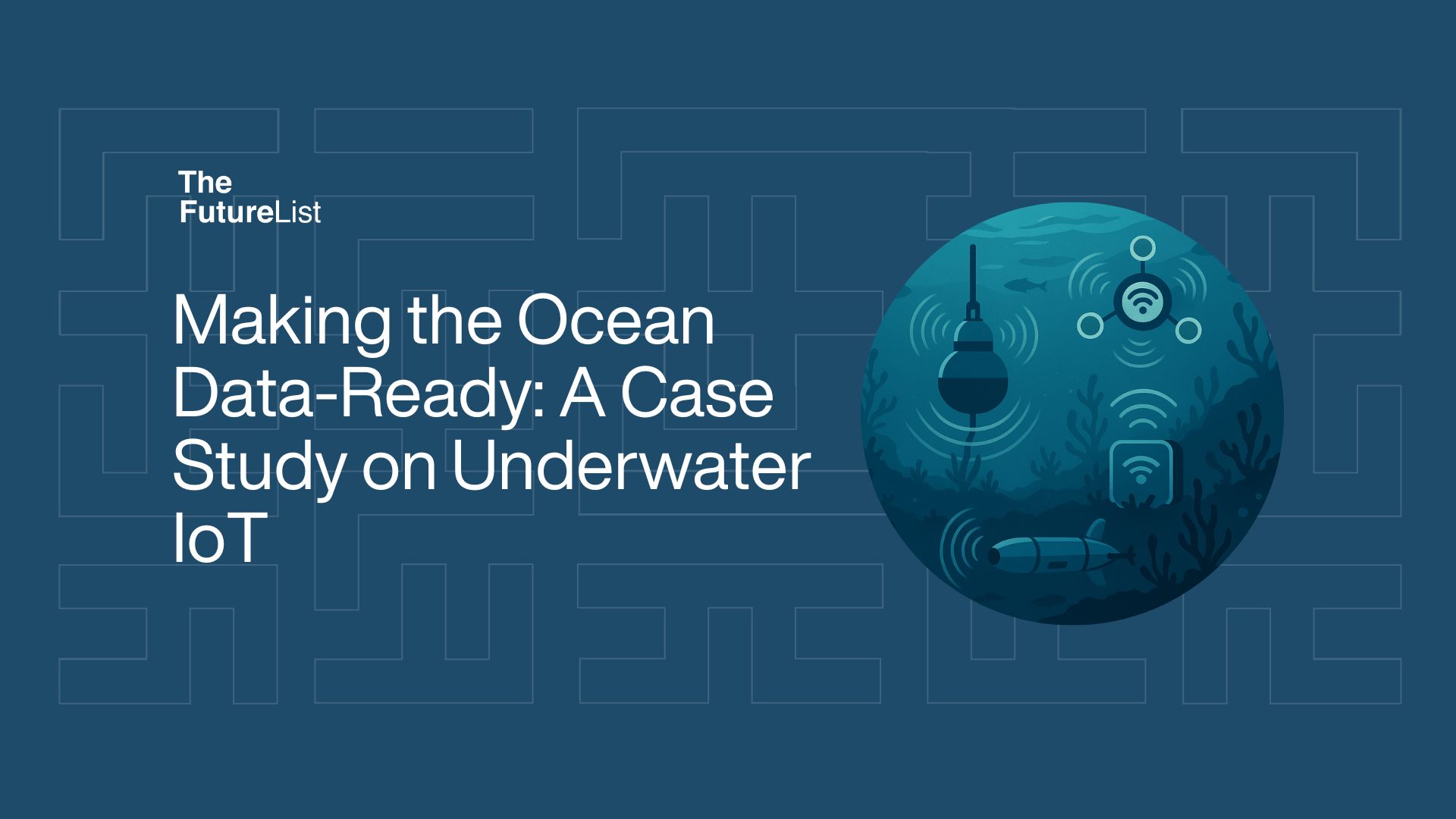
Making the Ocean Data-Ready: A Case Study on Underwater IoT
By Eric Kamande
As the climate crisis accelerates and marine infrastructure expands, the demand for real-time underwater data is rising. From aquaculture to offshore wind and environmental monitoring, industries are seeking smarter ways to monitor conditions beneath the surface. Yet the ocean remains one of the most data-dark environments on Earth. Traditional IoT systems, reliant on radio waves and stable power, don’t work well underwater. This is where the next frontier of connectivity is unfolding: underwater IoT.
Why Underwater IoT Matters
Only 5% of the world’s oceans have been explored, yet oceans support everything from global climate regulation to the livelihoods of hundreds of millions. Coastal infrastructure, underwater pipelines, offshore renewables, aquaculture farms, and marine ecosystems all require reliable monitoring, but existing communications systems fall short.
Unlike on land, where wireless signals travel easily through air, the underwater environment poses significant challenges. Radio waves degrade quickly. GPS signals don’t reach beneath the surface. Acoustic methods are slow and prone to interference. Until recently, underwater communication relied on tethered systems or ship-based monitoring, limiting scalability and responsiveness.
But that’s changing. Startups and research labs are now pushing boundaries in underwater communication, embedding intelligence into submerged sensors, deploying autonomous underwater vehicles (AUVs), and advancing low-power networks that bridge the data gap from sea floor to surface cloud.
Case Study: CSignum’s Breakthrough in Underwater Wireless
Founded in 2020 and led by CEO Jonathan Reeves, CSignum recently raised £6 million in Series A funding to scale its operations. Its core offering, a patented electromagnetic field signaling (EMFS) system known as EM-2, allows wireless transmission of data through difficult environments like water, soil, ice, and even concrete — a capability that has long evaded conventional methods.
Unlike tethered or acoustic systems, CSignum’s technology allows sensors to operate untethered and autonomously. It is currently being deployed in real-time water quality monitoring projects and used for wireless condition monitoring of underwater infrastructure, including offshore wind turbines and pipelines. EM-2 also serves defense and maritime use cases that rely on rapid and reliable underwater data delivery.
CSignum complements its hardware with a cloud-based analytics platform. The CSignum Cloud enables customers to visualize data in real time, integrate sensor streams, and receive alerts, ensuring data captured underwater translates into actionable insight on the surface.
Why Investor Interest Is Growing
The surge in funding for underwater IoT companies like CSignum reflects a wider shift in how industries think about oceans and water infrastructure. Three trends stand out:
- Rising regulatory pressure: Across the UK, EU, and U.S., new mandates are requiring continuous monitoring of water quality, offshore infrastructure, and emissions, with harsh penalties for non-compliance. Technologies like EM-2 offer scalable, low-maintenance ways to meet those requirements.
- Expanding industrial use cases: From aquaculture to port logistics and undersea cables, industries are recognizing the business value of underwater data. Better insight allows for faster response times, reduced maintenance costs, and more predictive planning.
- Technical breakthroughs in connectivity: EMFS, acoustic networking, and new energy-harvesting systems are overcoming the traditional pain points of battery life, data latency, and signal loss underwater, making commercial-scale deployment viable.
A Strategic Bet on the Future of Marine Data
CSignum’s edge lies not just in its core technology but in how it positions itself at the intersection of IoT hardware, environmental resilience, and real-time analytics. As oceans play a growing role in climate policy, food systems, and clean energy, demand for accurate, real-time underwater intelligence is only set to grow.
The company’s recent funding will go toward expanding its engineering team and product suite, with a focus on meeting the rising need for scalable, autonomous sensing in underwater environments.
For industries and governments navigating climate uncertainty, underwater IoT may be the key to unlocking what’s long been invisible and turning it into usable, reliable intelligence.
Get innovation insights from The FutureList weekly. Subscribe to our newsletter here
Categories
- Agritech
- Artificial Intelligence
- Biotech
- Blockchain
- Climate Tech
- Data Infrastructure
- Edtech
- Events
- Fashion
- Fintech
- Healthtech
- Infrastructure
- Innovation Memos
- Innovation Scout Program
- Insight
- Insurtech
- Machine Learning
- Martech
- Mobility
- Music and Media
- Partner Offers
- Perks
- Procurement
- Proptech
- Retailtech
- Ridehailing
- Ridesharing
- Robotics
- Space Aviation
- Supply Chain
- Talent
- Telecoms
- Uncategorized
- Venture Capital
- Wastetech
- Women In Tech
Recent Posts
- The Formula for Future Speed: Data-Driven Performance in Racing
- Leveraging Next-Gen Endoscopic Interventions and Innovations for Healthcare
- Inside the Quiet Work of Operationalizing AI Ethics in Government
- The Evolution and Impact of DNA Cloning Technology
- The Infrastructure Layer for Ethical Supply Chains